Patrick Jenkins interviews Independent Animator Leslie Supnet
This is one in a series of Interviews I'm doing with Independent Animators
Interview with Independent Animator Leslie Supnet
By Patrick Jenkins

Photograph of Leslie Supnet
Originally from Winnipeg MB, Leslie Supnet now lives in Toronto. Her engaging cut out animated films explore the everyday and the dark undercurrents of life. Her films contain moments of sincerity and sad humour. She's screened her works at various festivals, cinemas and micro cinemas around the world.
Patrick Jenkins: How did you get interested in doing animation? Did you go to art school?
Leslie Supnet: Drawing has been a part of most of my life, though I didn't go to art school. I studied applied math in University, but didn't follow that path. I found out about Video Pool Media Art Centre through a circuit-bending workshop - messing around with low voltage kids electronic toys to make sound instruments. That was my first involvement with an Artist-Run Centre, experimenting and toying around with people who had similar interests and thoroughly enjoying it! It was the first time I felt like "Yes, this is where I belong." So I looked at the other workshops they were offering that season, and there was a computer animation workshop so I signed up for that.
Patrick Jenkins: You have a self-taught, d.i.y. (do it yourself) approach in the way you work with very basic materials (paper, coloured pens or pencils) and cut out figures.
Leslie Supnet: Yes, after taking some workshops I developed some techniques through experimentation, and research. Helen Hill's Recipe's For Disaster helped me out in many ways, as well as tips and tricks from Winnipeg animator Mike Maryniuk. Their inventiveness with materials available to them is constant inspiration. When I realized my work didn't have to be slick, and that I could carve out my own space in the world of experimental filmmaking I just went for it.
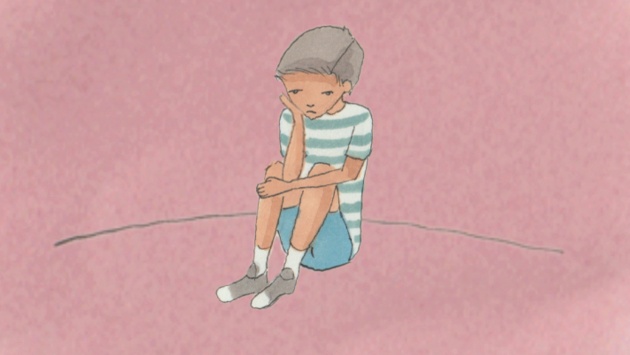
Still from "The Idea" by Leslie Supnet
Patrick Jenkins: Some of the drawings and characters in your films seem to be inspired by children's book illustration.
Leslie Supnet: Absolutely. As a child I really loved books by Maurice Sendak, Arnold Lobel, Richard Scarry, A.A. Milne and E.H. Shepard. I re-read Lobel’s book, Frog and Toad Are Friends every day! I learned to draw tracing Archie Comics, which I collected extensively. I would send in submissions to their Betty and Veronica design contests, but never got a response. Perhaps my fashions were too extreme.
Patrick Jenkins: (laughs) You were born and grew in Winnipeg, which is a city with a great cultural scene: music, visual arts, etc. What was it like growing up there?
Leslie Supnet: Winnipeg is not a city for the faint of heart. It's cold, desolate, and poor. Growing up was a bit rough, but it taught me a lot about empathy and community. I wasn't exposed to the wonderful arts scene till my mid-twenties, which brightened up my life for sure.
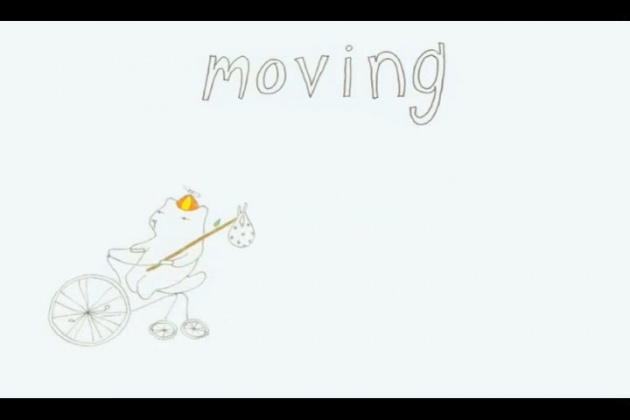
Patrick Jenkins: Your first cut out film was Moving (2007). It sets the tone and approach you’ll continue to use to make animation to the present day. A cutout cartoon pig wistfully watches a plane fly away and decides to build a very tall bike like vehicle to cycle to Winnipeg? Was this based on an incident in your life?
Leslie Supnet: Winnipeg has problems retaining their young talent. It's always been painful seeing friends leaving for Montreal, Vancouver or Toronto; and try to make a new life for themselves. Moving was made as a homage to that pain, but I wanted to create something cheeky about the idea of moving to Winnipeg rather than moving out of the city, represented in the cloud that falls, that the pig takes with him.
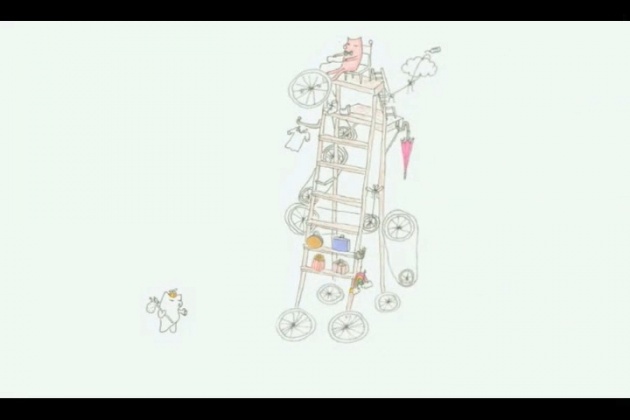
Stills from "Moving" by Leslie Supnet
Patrick Jenkins: How do you see the little hitchhiking cat or dog with the beanie who's left crying and eating popcorn at the end?
Leslie Supnet: It's funny, I can't remember now if that hitchhiking creature was supposed to be a dog or cat! Anyway, I see that the creature as those who struggle to leave their homes metaphorically, but only become spectators to others who are able to leave to find a new or better life.
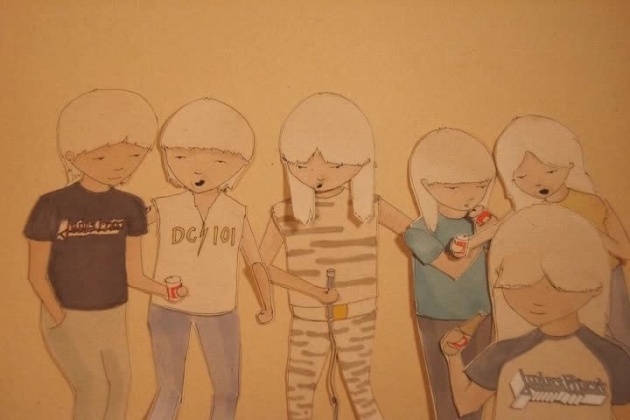
Still from "Animated Heavy Metal Parking Lot" by Leslie Supnet
Patrick Jenkins: A number of your films deal with popular culture. One, Animated Heavy Metal Parking Lot, is about metal heads waiting for a Judas Priest concert to start. It’s a reenactment in animation of a heavy metal documentary? Are you into Metal?
Leslie Supnet: The Animated Heavy Metal Parking Lot was made for a Winnipeg Film Group filmmaking contest, asking participants to remake a portion of a film of their choosing. At first I was going to remake scenes from The Sound of Music, since it was a film I really enjoyed. I would watch it over and over with my grandmother as a child. I quickly realized that pairing one of the songs with my illustrations would be a bit overbearingly sweet, so I thought of something else. What would be the opposite of The Sound of Music? Heavy Metal Parking Lot of course! And it turned out quite well. I'm not a mega fan of metal, but I do enjoy it on occasion!
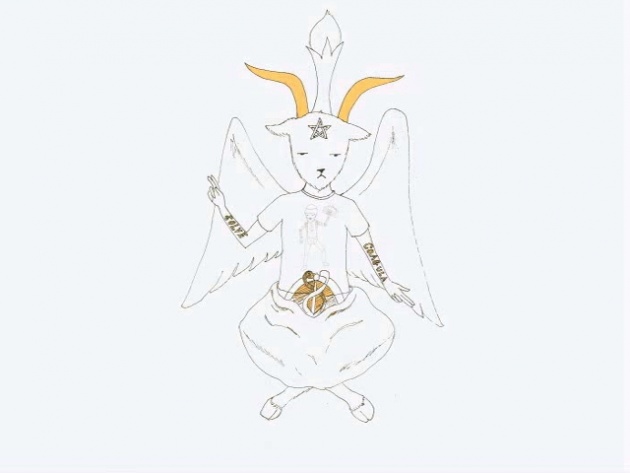
Still from "Closed Circle Of Worship" by Leslie Supnet
Patrick Jenkins: Your 2009 film Closed Circle of Worship seems to visit similar territory but incorporates live-action footage of a tap dancing rocker.
Leslie Supnet: Closed Circle of Worship was made as homage to The Dancing Outlaw, a TV movie produced for West Virginia public TV's Different Drummer series that showcases the tap-dancing rocker Jesco White from Boone County. He has repeated trouble with the law that has interfered with his dream of becoming as renowned a "mountain dancer" as his late father, D. Ray White. It's a heart-breaking story of an American family that really touched me. It was so strange and wonderful, that I felt like re-enacting Jesco's dancing in animation.
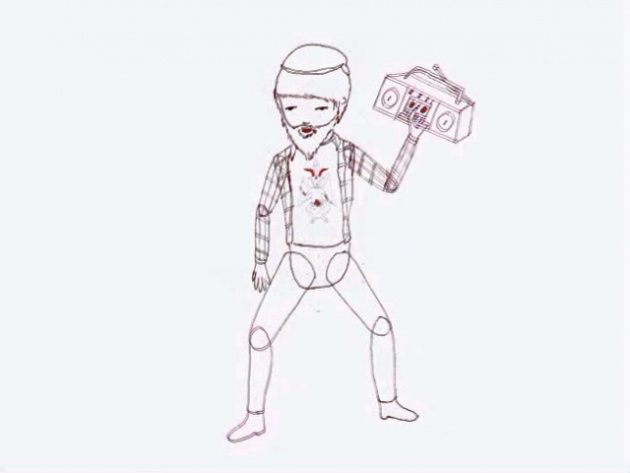
Still from "Closed Circle Of Worship" by Leslie Supnet
Patrick Jenkins: Can you talk about the meaning of the title Closed Circle of Worship?
Leslie Supnet: Closed Circle of Worship is meant to be a closed loop of admiration between Jesco White and Baphomet, whose image appears on Jesco's t-shirt in the found footage/live action bits. I had the idea of Baphomet wearing a shirt with Jesco dancing on it, and that's where the idea of a loop came in, to animate a perpetual admiration/inspiration feedback for both characters.
Patrick Jenkins: Did you ever meet Jesco White?
Leslie Supnet: No, I wish I had met him! The film was made purely for myself, to show my admiration for Jesco and the film The Dancing Outlaw. It’s a very good documentary, full of heart that shows the uniqueness of seemingly ordinary people. There's a recent documentary out about Jesco's family, called White Lightning that goes into their troubled life with the law.
Patrick Jenkins: You collaborate on most of your movies with filmmaker Clint Enns. Clint seems to handle the sound and music design while you do the animation.
Leslie Supnet: Clint and I have been collaborating since I began making animation in 2007. He is a great filmmaker, and editing and sound design came very naturally to him due to his obsessive Cinephilia. I haven't met anyone who has watched as many movies as he has, which informs how he makes a cut, or designs a musical score. For the most part, I finish an animation or film first, make a rough cut, then hand it over to him to do the soundtrack and fine cut.
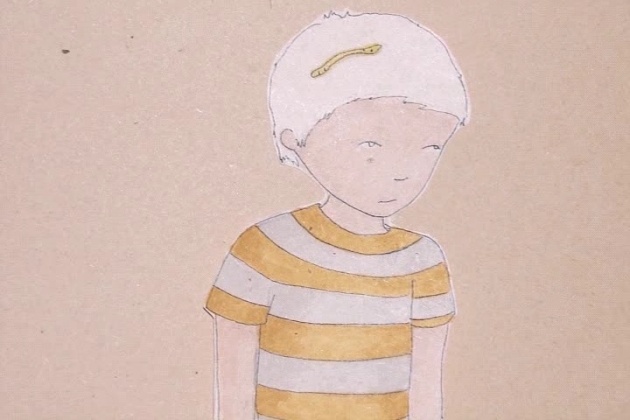
Still from "A Small Misunderstanding" by Leslie Supnet
Patrick Jenkins: Your 2008 film A Small Misunderstanding introduces the characters of children, drawn as if they’ve been extracted from an illustrated children’s book. A boy has a worm in his hair that attracts the attention of a hungry bird. So far so good, but things go terribly wrong. (Laughs)
Leslie Supnet: I believe at the time I had a falling out with a friend due to some kind of misunderstanding that at first was quite minuscule but turned into something larger. With this animation I wanted to illustrate how something quite insignificant can be the cause of such torment and pain. This short was really short, and made quickly as part of the Winnipeg Film Group's 1st annual 48-hour Filmmaking Contest.
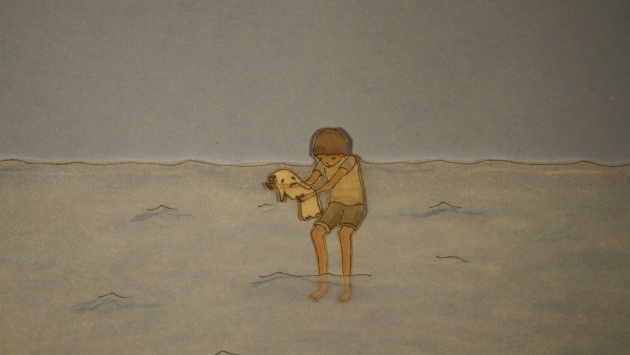
Still from "Gains and Losses" by Leslie Supnet
Patrick Jenkins: In this film you also introduce the character of the Ghost or Ghosts, who appear in some of your subsequent films? They look like Halloween ghosts. How do you see these ghosts?
Leslie Supnet: I’m still a bit obsessed with these ghosts. For me they represent loss - a long lost friend, love or family member, a lost time or moment. I can get very nostalgic, wrapping myself up in looking back at times past. They also represent an in-between existence that is changing or shifting. What I mean by that is the liminal space between who you once were and who you are becoming. You have the power to shape yourself. It represents that time in life when you realize you are growing up, and there's no turning back.
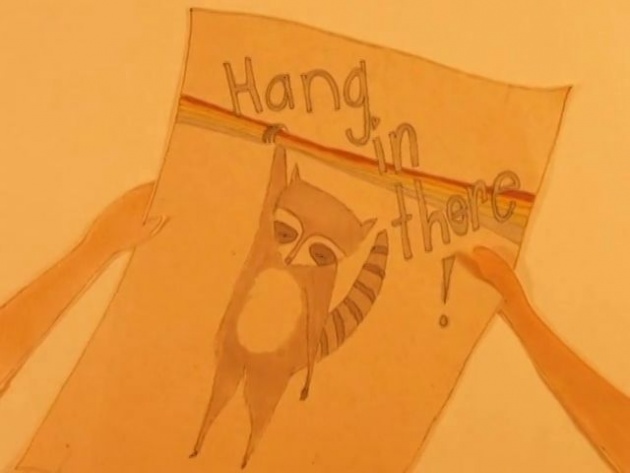
Patrick Jenkins: Continuing on the theme of children’s stories gone awry is your 2009 film Hang In There. Here a boy and girl rescue a bear, which looks like a spooky version of Milne’s Winnie The Pooh. Its head is stuck in a Bee Hive. Things just get worse from there as the children are attacked by mutant bee/bears. (Laughs) It’s as if the stories in the children’s imaginations have turned from fantasy to nightmare?
Leslie Supnet: Yes Hang in There was an animation that I made to tell the story of how, when you do good, sometimes a string of bad can come in return. Perhaps it's an anti-karma story. It is a bit negative; however in the children's time of need they are saved by enormous friendly flannel wearing bear (who is also wearing jeans) when they fall out of the sky. I feel like there's always risks involved when helping out your fellow man or woman, though it's well worth it.
Patrick Jenkins: The title Hang In There obviously plays on that ubiquitous 70’s motivational poster of a suspended cat that hung in every rec. room in North America right?
Leslie Supnet: Totally, I loved that poster as a child! It has such a positive message, while putting a real kitten in a precarious situation in the name of poster art. I found it a really complex image and message as a kid, so I wanted to play with that idea in my animation. I replaced the cat with a raccoon, and a raccoon is the character that shoots the poster to the boy in the air as a paper airplane as he is precariously suspended by the bear-bee mutants.
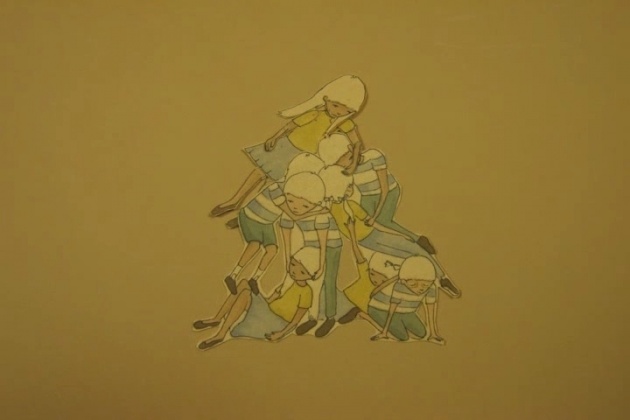
Still from "How To Care For Introverts" by Leslie Supnet
Patrick Jenkins: Your next film How To Care For Introverts (2010), starts a cycle of films about children (and by extension adults) encountering the complexities of life as they grow up. They seem like meditations on life and, in this case, a guide or words of advice how to deal with introverts.
Leslie Supnet: I like to search for images on the Internet a lot. On one of my daily image searches I stumbled upon a scanned page from a self-help book for parents on how to deal with their introverted child. It had specific points, which I then used as the over-voice in the animation. The film shows an introverted girl who falls from a pile of children. She pushes them away and covers them up with clouds, to give her the space that she needs to think, breathe, and be herself. I’m an introvert myself, and need moments where I can have space and time for myself in order to feel normal.
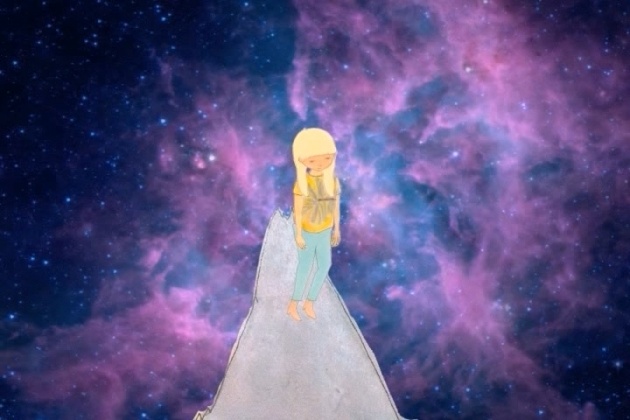
Still from "Fair Trade" by Leslie Supnet
Patrick Jenkins: You 2009 film Fair Trade, seems to explore a more spiritual dimension. A girl’s stomach opens up and childish stuff like video game consoles, a bike, the head of a puppet and buildings leap out of her. These things start to pile up on top of her and burden her. She tries to pawn or exchange them. Is this about growing up and leaving childish things behind?
Leslie Supnet: I deal with materialism quite a bit in my work. With Fair Trade I wanted to tell a story about purging oneself of actual physical stuff, as well as emotional baggage. The buildings that come out of her gut represent places she has lived, toys, previous pets, and dead family members...all the things she needs to let go of in order to achieve spiritual transformation. So yes, in a way, it is a story about growing up, as well as transcending the past and being able to be who you are in the moment.
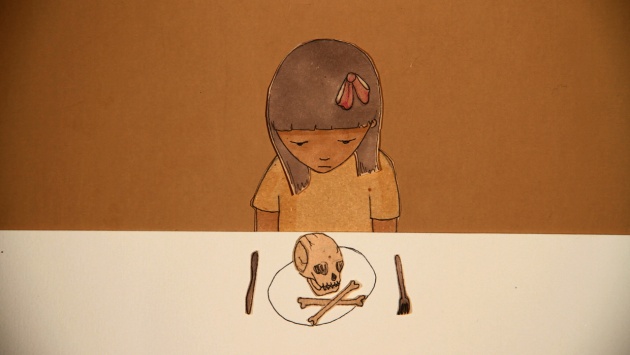
Still from "Gains and Losses" by Leslie Supnet
Patrick Jenkins: My favourite film of yours is Gains and Losses (2011). It’s a bittersweet meditation on life, how we make mistakes and how we lose some things, but gain others. The children appear again in this film, maybe on the cusp of becoming teenagers. One striking image in the film is a girl carving up and eating a skull.
Leslie Supnet: Gains and Losses is my most personal animation. The structure behind all the vignettes is an actual letter I wrote to my deceased cousin, who took her own life. I was struggling quite a bit with her death, as well as a break up I was going through at the time, so it was nice to focus on something other than those issues while making this work. The process of animation helped me a lot with that.
It was in those dark moments that I felt great resonance with a lot of cliché, sentimental phrases -- they finally had meaning to me. In the past those words felt too distant for them to feel sincere. It was through the experience of suffering I felt a connection. The image of the girl carving up and eating the skull was my interpretation of events of my cousin’s death. Illustrating it helped me deal with her death, or at least come to understand what was going on in her mind at that moment.
Patrick Jenkins: That brings us to your collaboration with author Glen Johnson in your films The Idea and A Time Is A Terrible Thing To Waste (both 2012). Who is he and why did you decide to collaborate with him?
Leslie Supnet: Glen Johnson, a writer and visual artist in Winnipeg, MB approached me one day to collaborate on a project – with me illustrating and animating his writing. I was a fan of his writing, and performance work so I agreed and it was fantastic. It was the first film I've done where the story wasn't my own. I really enjoyed the process and I'm working on another piece with him at the moment, called The Stupid Drunk.
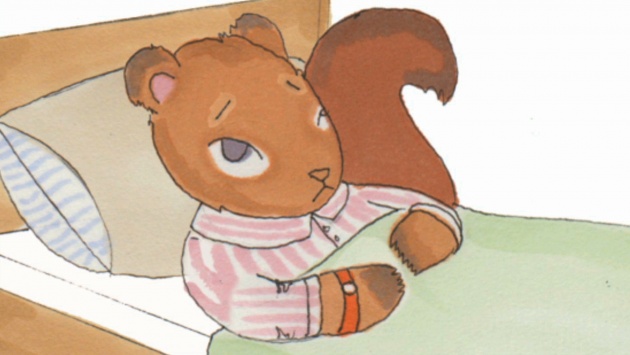
Still from "A Time Is A Terrible Thing To Waste" by Leslie Supnet
Patrick Jenkins: A Time Is A Terrible Thing To Waste show’s a squirrel in bed. The squirrel’s watch is broken and he worries that he won’t wake up in time to get to work. It seems like the characters are entering an adult world where they have adult responsibilities.
Leslie Supnet: Right, actually now that I think about it the story is an allegory about not wanting to grow up! Time is literally stopped (the broken watch) as the squirrel ponders, and ultimately procrastinates living his adult life. I didn't think of it this way until now!
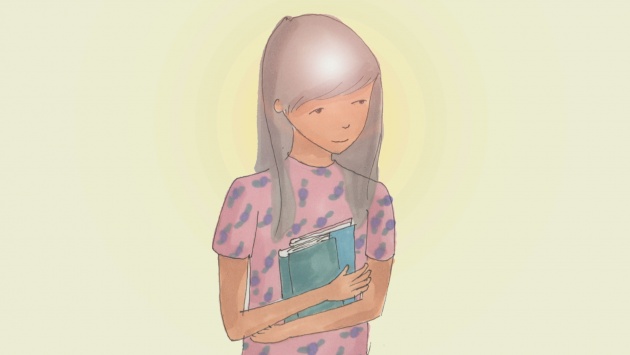
Still from "The Idea" by Leslie Supnet
Patrick Jenkins: I think many people in the arts can relate to the theme of plagiarism in The Idea. Ideas float around and can land anywhere. The storybook children seem to be at College now, dealing with the nefarious ways of the adult world?
Leslie Supnet: Plagiarism happens quite a bit in the arts, and in academia. It's really quite sad. For this story, I did illustrate older people, and adults! It was a first, and something I'm toying with. I still very much like to draw children though, the image of the child has way more impact with the messages I want to convey. The Idea is about intellectual property, having your ideas stolen, and also the struggle of getting a good idea realized in a meaningful way, which is what all artists have to deal with.
Patrick Jenkins: I hear that The Idea and A Time Is A Terrible Thing To Waste are both going to be shown on CBC Televisions Canadian Reflections show.
Leslie Supnet: Yes! Thanks to the Winnipeg Film Group they will be airing on Canadian Reflections on the following dates:
October 20th, 2013 at 12.30AM (ET) - The Idea (technically, Monday morning)
November 10th, 2013 at 12.30AM (ET) - A Time Is a Terrible Thing To Waste (technically, Monday morning)
Patrick Jenkins: Congratulations. Thanks for doing this interview Leslie. Best wishes with your work.
Leslie Supnet: Thanks Patrick for asking me to participate in this interview! I learned some new things about my own work during this process, which is sweet. Best wishes to you too!
(Images copyright Leslie Supnet, Interview Text copyright Patrick Jenkins and Leslie Supnet)



